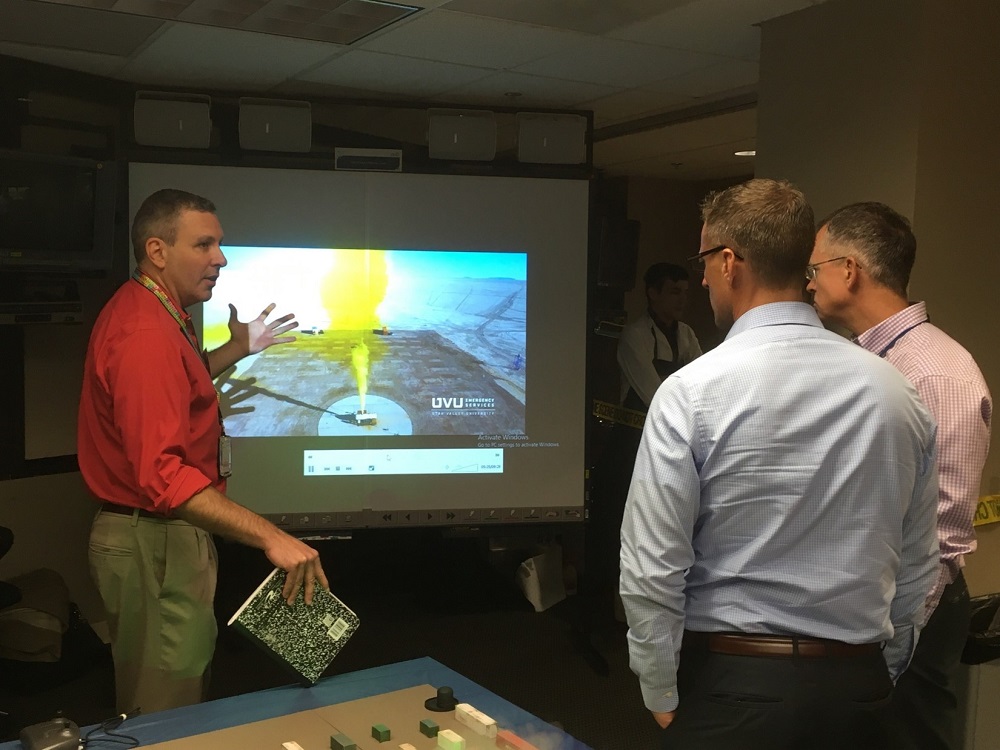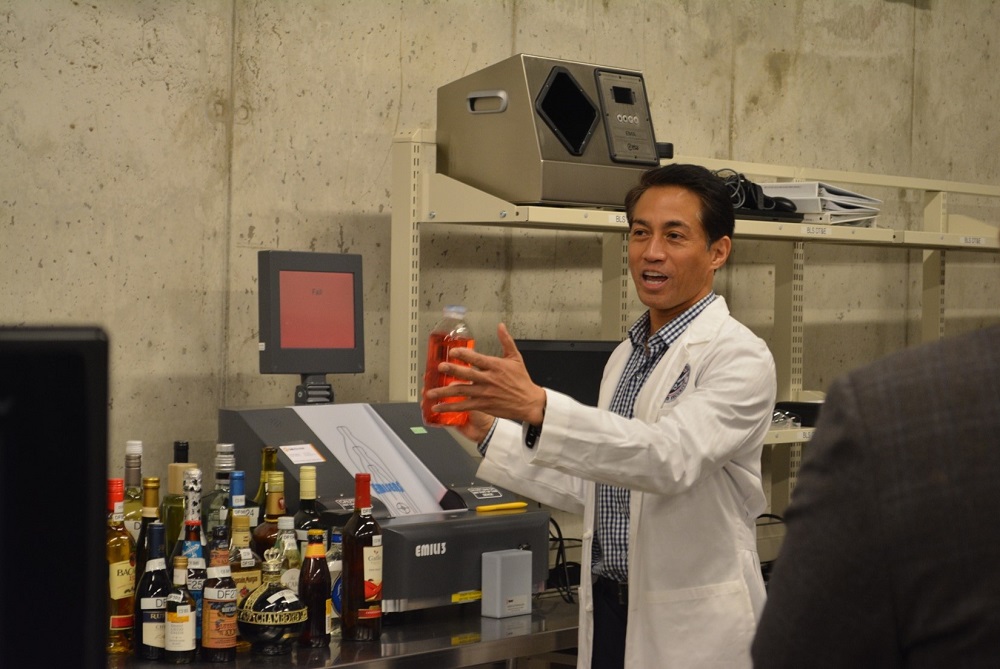We all know that securing the homeland is a monumental task. It takes manpower, skill, and training. It takes infrastructure and cutting-edge tools. It takes collaboration and innovation. And, you know what else it takes? Science.
We know this because it’s who we are. Science is not only in our name, it’s in our blood.
The Department of Homeland Security (DHS) Science and Technology Directorate (S&T) is leading the way in all these critical areas. We do this so that DHS and its components can help federal, state, local and tribal counterparts (as well as the public) prepare for and defend against a wide range of threats—from everyday emergencies to natural and manmade disasters. And yes, even global pandemics.
How does S&T do this? You might say we have it down to a science. (Pun very much intended.)
Without a lot of fanfare, this crucially important work is accomplished through deploying S&T’s advanced lab-based technical expertise and capabilities in research, development, test and evaluation (RDT&E). This vital work is performed by five independent yet mission aligned laboratories at seven sites that are all managed and operated by S&T.
“Our in-house labs offer technical support, infrastructure and core capabilities that produce hard science to support the mission,” said Julie Brewer, director of S&T’s Office of National Laboratories (ONL). “These labs are key because their capabilities align to the core DHS mission, which allows us to do much of the science in-house. This allows for efficient and effective execution—especially when time is of the essence,” she said.
Outlined in the Homeland Security Act of 2002, ONL’s “networked laboratory system” is pivotal to S&T’s success. Within the labs, hundreds of scientists and support staff work tirelessly to provide DHS and its partners with a wealth of lab-based science to assist decision-making, improve DHS component operations in the field, and inform acquisitions—among many other applications. These advanced capabilities are in the areas of chemical, biological, animal disease, explosives detection/mitigation, radiological and first responder support.
Enhancing chemical security through analysis
 Emergency planners and first responders need actionable information about chemical threats or hazards at a moment’s notice. In communities across the country through which chemicals are transported by truck and rail, or where residential neighborhoods meet industrial areas, having actionable scientific data and tools can mean the difference between sickness and health, and sometimes life or death. Based in Aberdeen, Maryland, the Chemical Security Analysis Center (CSAC) is the nation’s only federal studies, analysis and knowledge management lab for assessing these kinds of chemical threats and hazards, whether from accidental incidents or intentional acts of terrorism.
Emergency planners and first responders need actionable information about chemical threats or hazards at a moment’s notice. In communities across the country through which chemicals are transported by truck and rail, or where residential neighborhoods meet industrial areas, having actionable scientific data and tools can mean the difference between sickness and health, and sometimes life or death. Based in Aberdeen, Maryland, the Chemical Security Analysis Center (CSAC) is the nation’s only federal studies, analysis and knowledge management lab for assessing these kinds of chemical threats and hazards, whether from accidental incidents or intentional acts of terrorism.
With Project Jack Rabbit, for instance, the lab is helping emergency managers understand the nature and impact of large scale toxic chemical releases. CSAC’s HExCAT modeling tool helps state and local governments plan for and mitigate potential explosive attacks, and the Chemical Agents Reactions Database equips law enforcement with resources to solve chemical-related crimes. CSAC has also advised DHS agencies on chemical detection solutions to screen for the trafficking of synthetic opioids into America via mail. Most recently, during the record-breaking 2020 hurricane season, CSAC’s 24/7 technical assistance hotline stood ready to provide modeling and analysis regarding chemical hazards, vulnerabilities, and incidents. The lab did this so they could arm decision makers with the information needed to save lives and infrastructure that were in the path of destructive storms.
Watch the Chemical Security Analysis Center video
Understanding the nature of biological threats and hazards
 A biological attack on American soil could go undetected for hours, days, or weeks if not for the work of the scientific community. Located at Fort Detrick in Maryland, S&T’s National Biodefense Analysis and Countermeasures Center (NBACC) is the only maximum security biocontainment laboratory in the country dedicated to providing threat characterization and forensic analysis on biological agents for DHS and the Federal Bureau of Investigation (FBI). It is this expert assessment capability that can also assist authorities in understanding how deadly biological pathogens can be used by bad actors to harm innocent people.
A biological attack on American soil could go undetected for hours, days, or weeks if not for the work of the scientific community. Located at Fort Detrick in Maryland, S&T’s National Biodefense Analysis and Countermeasures Center (NBACC) is the only maximum security biocontainment laboratory in the country dedicated to providing threat characterization and forensic analysis on biological agents for DHS and the Federal Bureau of Investigation (FBI). It is this expert assessment capability that can also assist authorities in understanding how deadly biological pathogens can be used by bad actors to harm innocent people.
NBACC’s biosafety level 4 designation authorizes the lab to perform research on the most dangerous and deadly pathogens on the planet. Using their advanced aerobiology equipment, the lab was critical in the nation’s response to both the Ebola outbreak of 2014 and the SARS CoV-2 (the virus that causes COVID-19) global pandemic. As the COVID crisis intensified, NBACC produced groundbreaking novel insights on the virus’s survivability. Leveraging data from these NBACC studies, S&T developed two online calculators for emergency planners, responders and the general public to use in estimating the decay rate of SARS-CoV-2 on both surfaces and also while airborne under various environmental conditions.
Watch the National Biodefense Analysis and Countermeasures Center video
Serving as scientific advisors to first responders
 America’s urban areas have complex landscapes that present unique dangers and difficult operational challenges for our first responders. Whether it’s protecting people and property from acts of violence, responding to radiological or nuclear hazards, enabling better communication, or just getting to incidents faster, first responders rely on sound science and technology to get the job done. Police, firefighters, emergency medical personnel and responders shouldn’t have to question whether their gear does what it is supposed to do. That’s where S&T’s National Urban Security Technology Laboratory (NUSTL) proves indispensable.
America’s urban areas have complex landscapes that present unique dangers and difficult operational challenges for our first responders. Whether it’s protecting people and property from acts of violence, responding to radiological or nuclear hazards, enabling better communication, or just getting to incidents faster, first responders rely on sound science and technology to get the job done. Police, firefighters, emergency medical personnel and responders shouldn’t have to question whether their gear does what it is supposed to do. That’s where S&T’s National Urban Security Technology Laboratory (NUSTL) proves indispensable.
NUSTL works closely with interagency partners and multinational stakeholders—as well as the responders themselves—to test and evaluate a wide range of technologies in order to improve performance and assess capabilities and limitations. Located in New York City, NUSTL has the advantage of studying these technologies both in the lab and in operational settings. From its Manhattan home, the lab is able to strategically use the city’s landscape as one of the world’s largest urban testbeds. Whether through field assessments or the System Assessment and Validation for Emergency Responders (SAVER) program, NUSTL’s work often informs agencies’ decisions to purchase or deploy technologies altogether.
Watch the National Urban Security Technology Laboratory video
Conducting crucial animal disease research
 Certain diseases found in livestock pose grave threats to our agricultural economy. A secure homeland means preparing for those threats before they reach our shores or mitigating the impact if they do arrive. S&T’s Plum Island Animal Disease Center (PIADC), located in Orient Point, New York, defends our agricultural economy against accidental or intentional introductions of foreign animal diseases that impact livestock and threaten our food supply.
Certain diseases found in livestock pose grave threats to our agricultural economy. A secure homeland means preparing for those threats before they reach our shores or mitigating the impact if they do arrive. S&T’s Plum Island Animal Disease Center (PIADC), located in Orient Point, New York, defends our agricultural economy against accidental or intentional introductions of foreign animal diseases that impact livestock and threaten our food supply.
PIADC works with the U.S. Department of Agriculture to study and develop vaccines for high-threat foreign animal diseases, such as foot-and-mouth disease (FMD) and African swine fever virus (ASFv). PIADC is the only U.S. federal laboratory permitted to work with live FMD virus and in 2020, it patented a new, safer vaccine development process. In partnership with industry, PIADC also tested and evaluated a novel rapid ASFv field test that provides results within hours and can be used in the field or at border checkpoints during meat and animal inspections. This technology will help the government and the pork industry mitigate threats posed by accidental or intentional introduction of ASFv into the U.S.
In 2023, PIADC’s mission will relocate to the new National Bio and Agro-Defense Facility, a state-of-the-art maximum biocontainment facility currently under construction in Manhattan, Kansas.
Watch the Plum Island Animal Disease Center video
Advancing transportation detection capabilities through science
 The federal government screens over two million passengers, one million checked items, and five million carry-on items every day for the presence of explosives and other contraband. This is a colossal undertaking, so S&T’s Transportation Security Laboratory (TSL), located in Atlantic City, New Jersey, works closely with equipment manufacturers to ensure that those conducting the screenings have detection technology that meets their needs.
The federal government screens over two million passengers, one million checked items, and five million carry-on items every day for the presence of explosives and other contraband. This is a colossal undertaking, so S&T’s Transportation Security Laboratory (TSL), located in Atlantic City, New Jersey, works closely with equipment manufacturers to ensure that those conducting the screenings have detection technology that meets their needs.
TSL is a domestic leader in the development of standards, protocols, and “test articles” (such as simulated explosives, etc.) that are necessary for detection technology assessments. The lab also investigates the properties of explosives (and other contraband) to assist in the design of these test articles, which are used to evaluate the effectiveness of screening systems. For seamless coordination, TSL manages S&T’s capabilities in homemade explosives threat characterization by overseeing the Detection Technology Center (DTC) in Huntsville, Alabama, and Tyndall Reactive Materials Group (TRMG) located in Panama City, Florida.
TSL has even received several patents for test articles involving x-ray and millimeter wave-based systems as well as for quality control methods for explosives trace detectors. With a nod to the future, TSL experts are currently evaluating artificial intelligence and machine learning capabilities with potential to improve security in our transportation systems.
Watch the Transportation Security Laboratory
Clearly, these five S&T federal laboratories represent an unrivaled and indispensable source for trailblazing RDT&E. DHS operational components, other stakeholders and the general public rely on them for pioneering science that spans the sprawling mission to protect our nation.
“Individually, each of our S&T labs is a national asset, but together they form the foundation for so much that S&T does to support the homeland security mission,” said Brewer. “It’s not an exaggeration to say that we do the science that keeps America safe.”
For more information about S&T’s Office of National Laboratories, please visit https://www.dhs.gov/science-and-technology/office-national-laboratories.




